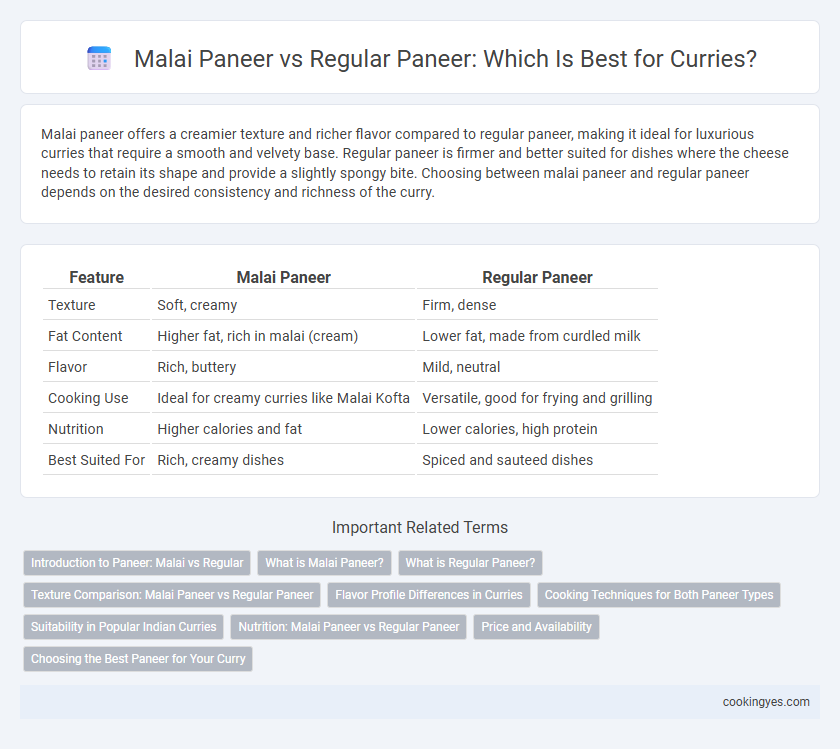Malai paneer offers a creamier texture and richer flavor compared to regular paneer, making it ideal for luxurious curries that require a smooth and velvety base. Regular paneer is firmer and better suited for dishes where the cheese needs to retain its shape and provide a slightly spongy bite. Choosing between malai paneer and regular paneer depends on the desired consistency and richness of the curry.
Table of Comparison
| Feature | Malai Paneer | Regular Paneer |
|---|---|---|
| Texture | Soft, creamy | Firm, dense |
| Fat Content | Higher fat, rich in malai (cream) | Lower fat, made from curdled milk |
| Flavor | Rich, buttery | Mild, neutral |
| Cooking Use | Ideal for creamy curries like Malai Kofta | Versatile, good for frying and grilling |
| Nutrition | Higher calories and fat | Lower calories, high protein |
| Best Suited For | Rich, creamy dishes | Spiced and sauteed dishes |
Introduction to Paneer: Malai vs Regular
Malai paneer is creamier and softer due to the addition of fresh cream during preparation, making it ideal for rich, indulgent curries like Shahi Paneer. Regular paneer has a firmer texture and slightly spongier consistency, which holds shape better in robust, spicy curries such as Paneer Tikka Masala. The choice between malai and regular paneer significantly affects the texture and richness of the dish, influencing cooking methods and final flavor profiles.
What is Malai Paneer?
Malai Paneer is a cream-enriched variant of traditional paneer, characterized by its softer texture and richer flavor, making it ideal for creamy curries like Malai Kofta and Paneer Butter Masala. Unlike regular paneer, which is firm and crumbly, Malai Paneer is made by curdling milk with added cream or double cream, resulting in a higher fat content that enhances the dish's smoothness and mouthfeel. This creamy composition allows Malai Paneer to absorb spices and flavors more effectively, elevating the richness and indulgence of Indian vegetarian curries.
What is Regular Paneer?
Regular paneer is a fresh Indian cheese made by curdling milk with lemon juice or vinegar, known for its firm and crumbly texture that holds shape well in curries. It absorbs spices and flavors efficiently, making it ideal for dishes like paneer tikka, palak paneer, and paneer butter masala. Unlike malai paneer, which is creamier and softer due to added cream or milk solids, regular paneer provides a denser consistency that stands out in rich, spiced gravies.
Texture Comparison: Malai Paneer vs Regular Paneer
Malai Paneer has a softer, creamier texture due to higher fat content, making it ideal for rich, creamy curries like Shahi Paneer. Regular paneer is firmer and more crumbly, holding its shape better in spicy, dry curries such as Paneer Tikka or Kadai Paneer. Texture differences influence cooking methods and mouthfeel, with malai paneer dissolving slightly and regular paneer providing a chewy bite.
Flavor Profile Differences in Curries
Malai Paneer offers a creamier and richer texture, enhancing curries with a delicate buttery flavor and subtle sweetness that balances spice levels effectively. Regular Paneer features a firmer consistency with a more neutral taste, allowing it to absorb and highlight the spices and herbs used in curries without altering their fundamental flavor profiles. The choice between Malai Paneer and Regular Paneer significantly influences the mouthfeel and overall taste complexity of traditional Indian dishes like paneer butter masala and palak paneer.
Cooking Techniques for Both Paneer Types
Malai paneer, known for its richer fat content, requires gentle cooking techniques such as slow simmering or light sauteing to preserve its soft texture in curries. Regular paneer holds up well to high-heat methods like frying or roasting, which help maintain its firm structure and create a crispy exterior. Choosing the appropriate cooking technique enhances the paneer's texture and flavor profile, optimizing the curry's overall taste experience.
Suitability in Popular Indian Curries
Malai Paneer, with its softer texture and higher fat content, is highly suitable for creamy Indian curries like Paneer Butter Masala and Shahi Paneer, where richness enhances the dish. Regular Paneer, firmer and less creamy, holds its shape well in dry or semi-gravy curries such as Kadhai Paneer and Mutter Paneer, providing a robust texture. Choosing Malai or regular paneer directly influences the curry's mouthfeel and overall authenticity in traditional Indian cuisine.
Nutrition: Malai Paneer vs Regular Paneer
Malai Paneer contains higher fat content and calories compared to regular paneer due to the cream (malai) used in its preparation, making it richer and more energy-dense. Regular paneer is lower in fat and calories while maintaining a high protein level, making it a better option for those seeking a leaner source of dairy protein. Both types provide essential nutrients like calcium and phosphorus, but regular paneer supports weight management better due to its reduced fat content.
Price and Availability
Malai Paneer tends to be pricier than regular paneer due to its higher fat content and richer texture, making it a premium choice for creamy curries. Regular paneer is widely available in most grocery stores and local markets, making it a cost-effective option for everyday cooking. While malai paneer adds a velvety consistency to dishes, regular paneer remains the more accessible and budget-friendly ingredient for various curry recipes.
Choosing the Best Paneer for Your Curry
Malai paneer offers a creamier texture and richer taste due to its higher fat content, making it ideal for silky, indulgent curries like shahi paneer and malai kofta. Regular paneer, with its firmer consistency and milder flavor, holds shape better in robust, spiced dishes such as paneer tikka masala or kadai paneer. Selecting the best paneer depends on the desired curry texture and flavor intensity, balancing creaminess with structural integrity for optimal culinary results.
Malai Paneer vs Regular Paneer for curries Infographic

 cookingyes.com
cookingyes.com